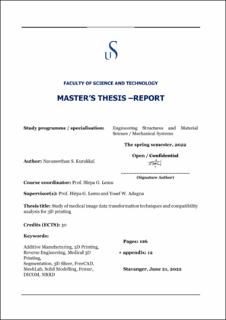| dc.description.abstract | Various applications exist for additive manufacturing (AM) and reverse engineering (RE) within the
medical sector. One of the significant challenges identified in the literature is the accuracy of 3D
printed medical models compared to their original CAD models. Some studies have reported that 3D
printed models are accurate, while others claim the opposite. This thesis aims to highlight the medical
applications of AM and RE, study medical image reconstruction techniques into a 3D printable file
format, and the deviations of a 3D printed model using RE. A case study on a human femur bone was
conducted through medical imaging, 3D printing, and RE for comparative deviation analysis. In
addition, another medical application of RE has been presented, which is for solid modelling.
Segmentation was done using opensource software for trial and training purposes, while the
experiment was done using commercial software. The femur model was 3D printed using an industrial
FDM printer. Three different non-contact 3D scanners were investigated for the RE process. Post-processing of the point cloud was done in the VX Elements software environment, while mesh
analysis was conducted in MeshLab. The scanning performance was measured using the VX Inspect
environment and MeshLab. Both relative and absolute metrics were used to determine the deviation
of the scanned models from the reference mesh. The scanners' range of deviations was approximately
from -0.375 mm to 0.388 mm (range of about 0.763mm) with an average RMS of about 0.22 mm.
The results showed that the mean deviation of the 3D printed model (based on 3D scanning) has an
average range of about 0.46mm, with an average mean value of about 0.16 mm. | |
